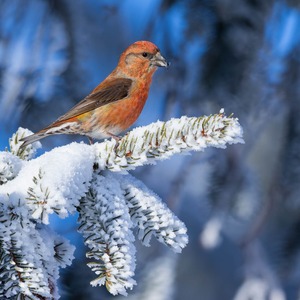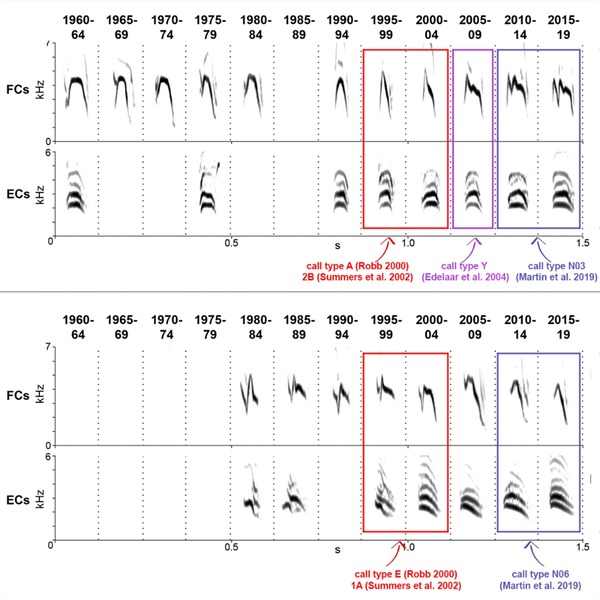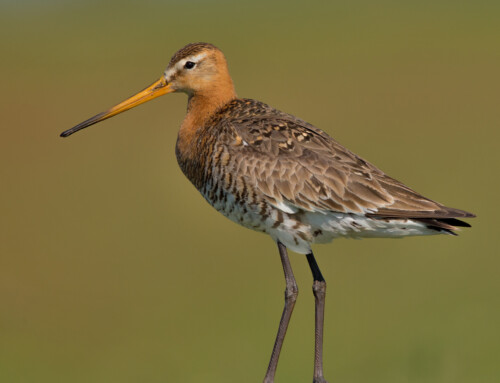 LINKED PAPER
LINKED PAPER
Fast cultural evolution of Crossbill (Loxia spp.) calls in the Palaearctic. Martin, R., Rochefort, J., Mundry, R. & Segelbacher, G. 2023 Ibis. doi: 10.1111/ibi.13253 VIEW
The significant variation observed in the calls of crossbills (Loxia spp.) has ignited numerous debates regarding its biological cause. Groth (1988) identified that specific populations, referred to as ‘call types’ or ‘vocal types’, could be distinguished by a unique pair of flight and excitement calls. Parents teach these calls to fledglings (Groth 1993; Seewall 2010), and typically, a bird does not change its call type throughout its life (Keenan & Benkman 2008; Seewall 2009).
In Europe, there have been several attempts to categorise crossbills calls into such call types, as seen in works by Clouet & Joachim (1996), and Förschler & Kalko (2009) for south-western Europe, Robb (2000), Summers et al. (2002), and Constantine & The Sound Approach (2006) for north-western Europe, and Martin et al. (2019 and 2020) for the western and eastern Palearctic respectively. However, while the flight calls described in these studies have been found to vary, the excitement calls largely concur. Additionally, upon examining some historical sound recordings of crossbills, we were struck by the fact that we couldn’t definitively identify any call type by its flight calls.
Given these discrepancies, our aim was to uncover the reasons behind these variable flight calls. We hypothesised that unnoticed geographical or temporal variations in the calls might account for these discrepancies. We analysed eight call types of the Red Crossbill (L. curvirostra), in addition to the Parrot (L. pytyopsittacus), Scottish (L. scotia), and Two-barred Crossbill (L. leucoptera).
Having collected more than 20,000 recordings of crossbills in the Palearctic from 1962 to 2019, we adopted the most recent classification (Martin et al. 2019 and 2020) and categorised the calls according to their defined call types. If both flight and excitement calls from the same bird were available, we assessed their adherence to the respective call type’s definition. Any deviation was added to the variation for that call type, and all recordings were then reviewed for similar calls to ensure a comprehensive range of call variations.
We also evaluated whether different call types influenced each other. Notably, we checked if the calls of N06 (Red Crossbill; typically found in northern Great Britain and Ireland) varied in relation of abundancy of invading call types in the region.
Our Findings

Figure 1 Temporal variation in call type N03 (above) and N06 (below). Each colour represents calls found in a distinct study, emphasising the unique temporal variations observed during that specific research period.
Across all crossbill species covered over extensive time periods in our dataset, we identified temporal variations in flight calls, except in the case of the Two-barred Crossbill. Geographical origin generally exerted minimal influence on these variations. In contrast, only the Red Crossbill N06 and the Scottish Crossbill N20 demonstrated noticeable temporal variations in their excitement calls.
Based on our observations, it seems several call types, as defined in past studies, are actually temporal snapshots from their respective research periods (Figure 1). Regrettably, the precise reasons for these changes remain elusive.

Figure 2 Variations in flight call (FC) similarity between the local (Great Britain and Ireland) call type N06 and the commonly invading call types N03, N04, and N08, mapped against the intensity of an invasion. The plot on the left illustrates FC changes during the invasion, while the one on the right shows FC similarity changes one season after the invasions.
One hypothesis for the change of these calls is, different call types influence each other, causing either an increase or decrease in call similarities when in contact. In our comparison of temporal similarities of different call types in Great Britain, no consistent pattern emerged. Nevertheless, in seasons marked by a high prevalence of invading call types and the subsequent season, the similarity in calls typically diminished (Figure 2).
Summing up, crossbill calls provide a fascinating example of exceptionally rapid cultural evolution, given the marked call alterations observed within 5-10 years across distances greater than 10,000 km.
For those keen on crossbill call types in the Palearctic region, consider exploring this blog post.
References
Clouet, M. & Joachim, J. 1996. Premiers élements de comparaison de trois populations françaises de beccroisés Loxia curvirostra. Alauda 64:149-155.
Constantine, M., & The Sound Approach. 2006. The Sound Approach to Birding. A guide to understanding bird sounds. The Sound Approach. VIEW
Förschler, M. I. & Kalko, E. K. V. 2009. Vocal types in crossbill populations (Loxia spp.) of Southwest Europe. Journal of Ornithology 150:17-27. VIEW
Groth, J. G. 1998. Resolution of cryptic species in Appalachian red crossbills. The Condor 90:747-760. VIEW
Groth, J. G. 1993. Evolutionary differentiation in morphology, vocalizations, and allozymes among nomadic sibling species in the North American Red Crossbill (Loxia curvirostra) complex. University of California Publications in Zoology 127:1-156. VIEW
Keenan, P. C. & Benkman, C. W. 2008. Call imitation and modification in Red Crossbills. Condor 110:93-101. VIEW
Martin, R., Rochefort, J., Mundry, R. & Segelbacher, G. 2019. Delimitation of call types of Red Crossbill (Loxia curvirostra) in the Western Palearctic. Écoscience 26:177-194. VIEW
Martin, R., Rochefort, J., Mundry, R. & Segelbacher, G. 2020. On the relative importance of ecology and geographic isolation as drivers for differentiation of call types of red crossbill Loxia curvirostra in the Palearctic. Journal of Avian Biology 51:1-15. VIEW
Robb, M. S. 2000. Introduction to vocalizations of crossbills in north-western Europe. Dutch Birding 22:61-107. VIEW
Sewall, K. B. 2009. Limited adult vocal learning maintains call dialects but permits pair-distinctive calls in red crossbills. Behavioral Ecology and Sociobiology 65:157-166. VIEW
Sewall, K. B. 2010. Early learning of discrete call variants in red crossbills: implications for reliable signaling. Ibis 163:928-947. VIEW
Summers, R. W., Jardine, D. C., Marquiss, M., & Rae, R. 2002. The distribution and habitats of crossbills Loxia spp. in Britain, with special reference to the Scottish Crossbill Loxia scotica. Ibis 144:393-410. VIEW
Image credit
Top right: Red Crossbill (Loxia curvirostra) call type N07 © Ralph Martin.
If you want to write about your research in #theBOUblog, then please see here.




